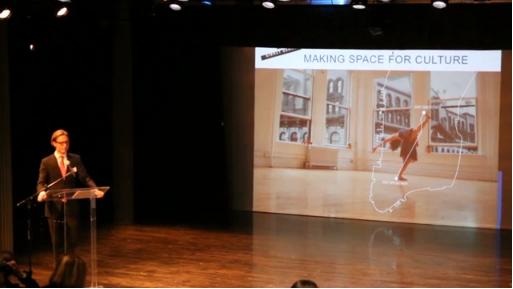There are lessons for the creative sector in the story of 280 Broadway, whose new tenant, Gibney Dance, opens its doors to the community to shape the future. In a real estate climate where too many are losing space and reporting escalating costs -- real threats to creative life -- some, like Gibney Dance, are making solutions.
The first of the lessons I offer here is the value of community engagement. As examples, opportunities for 280 Broadway are generated by the testimony of artists previously displaced by its closure in the fall of 2013 and new ideas brought forward both online through a Community Idea Portal and ongoing community forums. For example, see this video of a welcome session co-hosted by Dance/NYC.
For those focused on future space solutions, there is power to be leveraged through local community organizing--perhaps especially in non-Manhattan geographies, where increased attention by our sector, and all New Yorkers, is needed.
Second, there is a lesson learned from "'We Make Do' More Time Is Better, But Budget Is King,'" an Exploring the Metropolis study on dance rehearsal space commissioned by The Andrew W. Mellon Foundation. Crucially, the study recommends shifting focus away from new construction to expanding use of existing facilities. Such is the case with 280 Broadway, which in its new incarnation makes use of previously occupied dance work, training, rehearsal, and performance space.
Third, there is a lesson about efficiencies of scale, achieved at 280 Broadway through synergies with Gibney Dance's other spaces at 890 Broadway. Beyond administrative and cost savings, the expanded Gibney Dance can offer space and programs to better support artists and organizations along the continuums of creative process, from rehearsal to performance, and of career and institutional advancement, from emerging to mid-career. (State of NYC Dance research shows recent de-investment in mid-size organizations and the need to more fully consider creative trajectories.)
A final lesson is the importance of collaboration and partnerships to the making of space solutions. At 280 Broadway, partnerships cut across public, corporate, and creative sectors, and include the City of New York, Fram Realty, and a growing number of institutional investors, such as Agnes Varis Trust, and program providers. The space will also be home to a Center for Community Action, building on the work of Gibney Dance to serve survivors of domestic violence and address other social issues. In this way, it will strengthen ties between dance performance and social justice communities.
For others focused on making space solutions for arts and culture, I believe there is as yet untapped opportunity for building relationships both within and across sectors -- one lever for generating needed resources, achieving operational efficiencies, and scaling delivery of public value. I believe there may also be appropriate instances for moving beyond partnerships to mergers, for which New York Live Arts, the recent coming-together of Bill T. Jones/Arnie Zane Dance Company and Dance Theater Workshop provides a timely example of success.
These lessons are neither the only ones to learn from the story of 280 Broadway nor will they, if applied, be a cure-all for the creative sector. But I believe the new 280 Broadway is a big win for space making, and as a case study, it may contribute to the learning of those of us invested in the future of arts and culture in New York. I look forward to continuing to help support those who make and use space to make arts and culture in our great city.

